A bomb disposal squad member tries to pick up an IED while wearing an armoured suit
Jammu:
The device that brought down the Russian Metrojet airliner with 224 people on board in Egypt's Sinai this month, is no stranger to bomb disposal experts of the Indian Army.
 First detected more than two decades ago in Jammu and Kashmir, the 'soda can' improvised explosive device or IED is an easy to assemble killer which packs as much punch as a hand grenade if stuffed with a kilo of plastic explosive like RDX.
First detected more than two decades ago in Jammu and Kashmir, the 'soda can' improvised explosive device or IED is an easy to assemble killer which packs as much punch as a hand grenade if stuffed with a kilo of plastic explosive like RDX.
In the pressurised hold of a modern airliner, a soda can bomb would be even more potent. An explosion would shatter the airframe triggering violent decompression of the cabin which would suffocate passengers besides causing enough structural damage to bring the airliner down.
 At the headquarters of an Army counter explosive device unit in Akhnoor near Jammu, a model of a soda can bomb is one among many IEDs on display. None of them look like bombs at all - there is a teddy bear, a doll, a bouquet of flowers, a carton with four soft-drink bottles, a rolled-up mattress. Move any of these, even slightly, and a siren sounds. If these were real, you would be dead - there would be no siren, only an explosion.
At the headquarters of an Army counter explosive device unit in Akhnoor near Jammu, a model of a soda can bomb is one among many IEDs on display. None of them look like bombs at all - there is a teddy bear, a doll, a bouquet of flowers, a carton with four soft-drink bottles, a rolled-up mattress. Move any of these, even slightly, and a siren sounds. If these were real, you would be dead - there would be no siren, only an explosion.
 "It's a cat and mouse game," says Lt Colonel N Roshyan, who commands this Northern Command unit. Dealing with plastic explosives like RDX, he explains, is a big challenge. "They are light in weight. They can be moulded into any shape and size and they are a little difficult to detect which makes it a popular tool for terrorists."
"It's a cat and mouse game," says Lt Colonel N Roshyan, who commands this Northern Command unit. Dealing with plastic explosives like RDX, he explains, is a big challenge. "They are light in weight. They can be moulded into any shape and size and they are a little difficult to detect which makes it a popular tool for terrorists."
 And to explain just how difficult it is to detect an IED, I am asked to walk through what looks like a park that you would find in any neighbourhood. Except, it's not. It's an improvised explosive device range.
And to explain just how difficult it is to detect an IED, I am asked to walk through what looks like a park that you would find in any neighbourhood. Except, it's not. It's an improvised explosive device range.
As I walk across a barricade, an alarm sounds. I have just tripped an infra-red sensor. This could have been linked to a bomb which would instantly have been triggered. A few feet away, I am asked to sign into a guest book at a guard room. I open the book, an alarm sounds. And I know what that means.
 As I walk through the park, I step on something that feels like a stone. Except that its an anti-personnel mine. I never saw it and neither would anyone else who would have the misfortune of stepping on it. There are many other examples, all meant to reinforce the point that anything can be a bomb. Being alert is not an option.
As I walk through the park, I step on something that feels like a stone. Except that its an anti-personnel mine. I never saw it and neither would anyone else who would have the misfortune of stepping on it. There are many other examples, all meant to reinforce the point that anything can be a bomb. Being alert is not an option.
For more than two decades, the Army has learned, often the hard way, just how deadly improvised explosive devices can be. And how, they are often impossible to detect without the sharpest set of trained eyes.
Today, the Army uses a host of techniques to ward off the danger of IEDs. Road-opening parties in Jammu and Kashmir, which are out at the crack of dawn, specifically look out for IEDs, land mines and hidden home-assembled devices under culverts. These can be triggered either by remote control or through a fixed line which leads to a terrorist with the trigger in his hand.
IEDs can also be fitted with timers through which devices can be programmed to explode even 100 days later. According to Lt. Colonel Roshyan, "In the past two decades, we have been able to modify our drills and operational procedures. We have identified and procured relevant equipment. Our training methodology is dynamic and contemporary."
For soldiers out on patrol in an area with suspected IEDs, there are several layers of defence. Leading from the front are sniffer dogs - highly trained Labrador Retrievers or German Shepards which move in a set pattern on the instruction of their handlers. Each dog has been trained at the Army's Remount Veterinary Corps in Meerut.
 The training schedule of these dogs remains constant. Refresher courses every few weeks at the unit level ensure that the dog's mind remains stimulated so it is alert in changing scenarios.
The training schedule of these dogs remains constant. Refresher courses every few weeks at the unit level ensure that the dog's mind remains stimulated so it is alert in changing scenarios.
At the training range, I am introduced to a five-year-old Labrador Retriever named Dante. He's one of the best IED detectors in the Northern Command, a dog's whose nose saves lives. I follow Dante and his handler into a mock bus stop. All of a sudden, the dog freezes and quietly sits. He has detected something. His handler lifts up a bedding next to the dog and sure enough there is an explosive underneath.
Accompanying Army road-opening party are soldiers carrying jammers in backpacks which disrupt the signals of remote-controlled devices that can trigger IEDs. In other areas, jammers may be deployed in fixed locations while vehicle-based jammers are also used.
While the Army is reluctant to speak on the specific capabilities of the jammers, NDTV has learnt that most devices can operate in various modes including a "pre-initiation mode" where an IED with a remote-control can be made to explode by the Army without any input from the terrorist. Key to ensuring that the Army remains ahead of terrorists is to ensure that all radio bandwidths are effectively covered by jamming devices at all times.
 The game changes dramatically when an improvised explosive device is located and it has to be de-activated or destroyed. Unlike in the past, where bomb disposal technicians would immediately move in to physically disarm the system, the Army now uses Remotely Operated Vehicles (ROVs) as its preferred option.
The game changes dramatically when an improvised explosive device is located and it has to be de-activated or destroyed. Unlike in the past, where bomb disposal technicians would immediately move in to physically disarm the system, the Army now uses Remotely Operated Vehicles (ROVs) as its preferred option.
The British Wheelbarrow ROV is a battery operated rover with a host of cameras that give its operator the ability to see the IED from a safe distance. Capable of lifting up to 75 kg, the Wheelbarrow is often used to flip the bodies of terrorists who have been known to keep a live hand grenade under them moments before they are killed in an encounter.
In "mopping up" operations, the grenade goes off the moment the terrorist's body is moved by security forces. Not anymore. The impact of the blast, if any, is borne by the Rover, not by a soldier. ROVs also pull out improvised explosive devices from locations using mechanical claws and have a disrupter mechanism - essentially a gun which fires to safely destroy an IED before it can cause harm.
 But, at the end of the day, there are still situations where there can be no replacement for the bomb disposal technician, the officers and men who get right next to an explosive and physically disarm it.
But, at the end of the day, there are still situations where there can be no replacement for the bomb disposal technician, the officers and men who get right next to an explosive and physically disarm it.
It's an extraordinarily dangerous job where focus, skill and stamina are the difference between life and death.
Identified early on the basis of their ability to observe detail and handle ordinance carefully, the Indian Army's bomb disposal experts are trained at the College of Military Engineering in Pune. Officers attend the Combined Officers Explosives Course either soon after they are commissioned or up to ten years into service. Once trained, they are posted out to units fighting terror such as the Rashtriya Rifles in Jammu and Kashmir and specialised Counter Explosive Device Units deployed across the country.
Wearing bulky, heavily armour-plated bomb disposal suits, each weighing upwards of 40 kilos, the Army's bomb techs are protected on their chest, neck and head and peer through armoured visors while lying flat on the ground right next to an IED to minimise the impact of a blast.
 They have a telescopic manipulator to work with. The manipulator increases the distance between the man and the bomb and its claw can be used to extract an IED, but ultimately, disarming the device requires steady human fingers and an extraordinarily sharp mind.
They have a telescopic manipulator to work with. The manipulator increases the distance between the man and the bomb and its claw can be used to extract an IED, but ultimately, disarming the device requires steady human fingers and an extraordinarily sharp mind.
Helping the bomb techs do their job are officers who communicate through radios. Video imagery of just what the bomb tech is seeing goes back to the officer from the helmet mounted camera.
Every minute is precious. Bomb technicians cannot work endlessly. Despite a cooling mechanism inside the bomb suit, working for more than half an hour at a time, particularly in our summer conditions, is almost impossible.
Ultimately, detecting and countering Improvised Explosive Devices is a non-stop life and death game heavily based on changing technology. The men in these bomb disposal units of the Indian Army know that they are only as good as their last successful operation in detecting an IED.
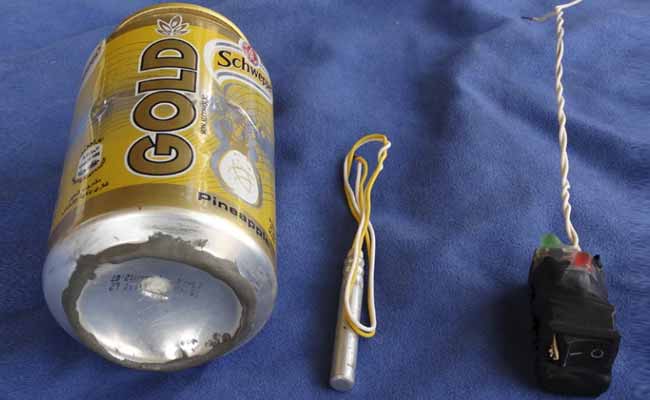
A photo of what ISIS's magazine Dabiq says was an explosive used to bring down a Russian airliner. (AFP PHOTO/HO/DABIQ)
In the pressurised hold of a modern airliner, a soda can bomb would be even more potent. An explosion would shatter the airframe triggering violent decompression of the cabin which would suffocate passengers besides causing enough structural damage to bring the airliner down.

An Improvised Explosive Device made with bottles of Pepsi
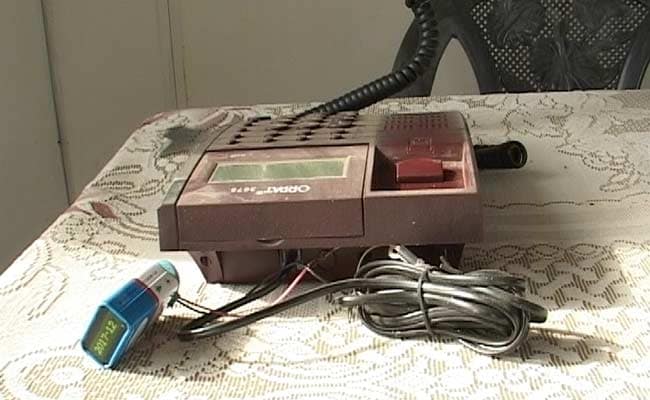
An IED hidden inside a phone
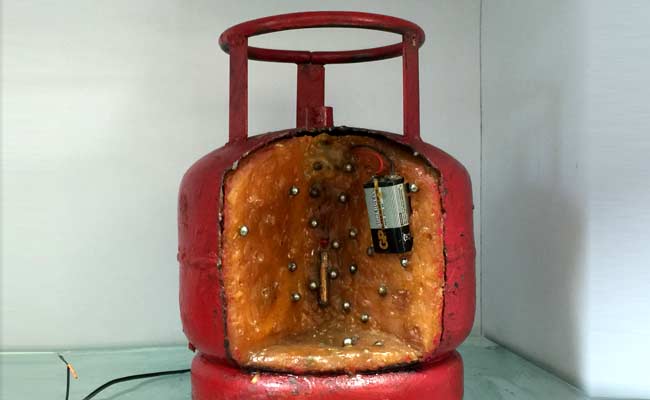
An IED hidden inside a cooking gas cylinder
As I walk across a barricade, an alarm sounds. I have just tripped an infra-red sensor. This could have been linked to a bomb which would instantly have been triggered. A few feet away, I am asked to sign into a guest book at a guard room. I open the book, an alarm sounds. And I know what that means.

Inside the guest book, an Improvised Explosive Device has been hidden
For more than two decades, the Army has learned, often the hard way, just how deadly improvised explosive devices can be. And how, they are often impossible to detect without the sharpest set of trained eyes.
Today, the Army uses a host of techniques to ward off the danger of IEDs. Road-opening parties in Jammu and Kashmir, which are out at the crack of dawn, specifically look out for IEDs, land mines and hidden home-assembled devices under culverts. These can be triggered either by remote control or through a fixed line which leads to a terrorist with the trigger in his hand.
IEDs can also be fitted with timers through which devices can be programmed to explode even 100 days later. According to Lt. Colonel Roshyan, "In the past two decades, we have been able to modify our drills and operational procedures. We have identified and procured relevant equipment. Our training methodology is dynamic and contemporary."
For soldiers out on patrol in an area with suspected IEDs, there are several layers of defence. Leading from the front are sniffer dogs - highly trained Labrador Retrievers or German Shepards which move in a set pattern on the instruction of their handlers. Each dog has been trained at the Army's Remount Veterinary Corps in Meerut.
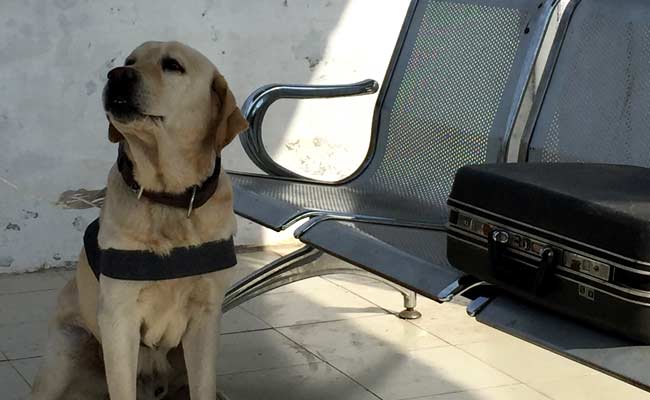
A highly trained Labrador Retriever named Dante spots an IED hidden inside a briefcase
At the training range, I am introduced to a five-year-old Labrador Retriever named Dante. He's one of the best IED detectors in the Northern Command, a dog's whose nose saves lives. I follow Dante and his handler into a mock bus stop. All of a sudden, the dog freezes and quietly sits. He has detected something. His handler lifts up a bedding next to the dog and sure enough there is an explosive underneath.
Accompanying Army road-opening party are soldiers carrying jammers in backpacks which disrupt the signals of remote-controlled devices that can trigger IEDs. In other areas, jammers may be deployed in fixed locations while vehicle-based jammers are also used.
While the Army is reluctant to speak on the specific capabilities of the jammers, NDTV has learnt that most devices can operate in various modes including a "pre-initiation mode" where an IED with a remote-control can be made to explode by the Army without any input from the terrorist. Key to ensuring that the Army remains ahead of terrorists is to ensure that all radio bandwidths are effectively covered by jamming devices at all times.

A remote controlled robot that is used to deal with IEDs
The British Wheelbarrow ROV is a battery operated rover with a host of cameras that give its operator the ability to see the IED from a safe distance. Capable of lifting up to 75 kg, the Wheelbarrow is often used to flip the bodies of terrorists who have been known to keep a live hand grenade under them moments before they are killed in an encounter.
In "mopping up" operations, the grenade goes off the moment the terrorist's body is moved by security forces. Not anymore. The impact of the blast, if any, is borne by the Rover, not by a soldier. ROVs also pull out improvised explosive devices from locations using mechanical claws and have a disrupter mechanism - essentially a gun which fires to safely destroy an IED before it can cause harm.
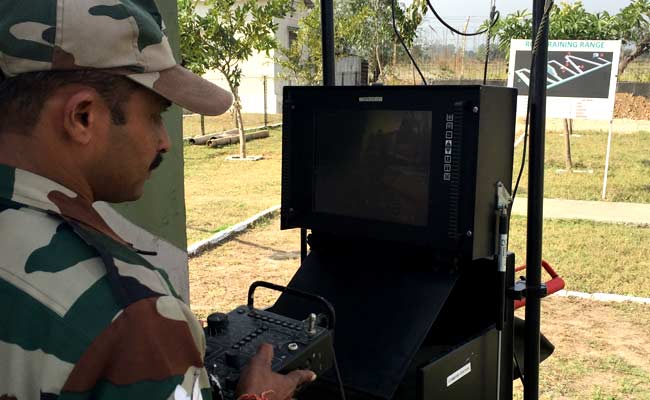
A bomb disposal squad member operates the ROV from a safe distance
It's an extraordinarily dangerous job where focus, skill and stamina are the difference between life and death.
Identified early on the basis of their ability to observe detail and handle ordinance carefully, the Indian Army's bomb disposal experts are trained at the College of Military Engineering in Pune. Officers attend the Combined Officers Explosives Course either soon after they are commissioned or up to ten years into service. Once trained, they are posted out to units fighting terror such as the Rashtriya Rifles in Jammu and Kashmir and specialised Counter Explosive Device Units deployed across the country.
Wearing bulky, heavily armour-plated bomb disposal suits, each weighing upwards of 40 kilos, the Army's bomb techs are protected on their chest, neck and head and peer through armoured visors while lying flat on the ground right next to an IED to minimise the impact of a blast.
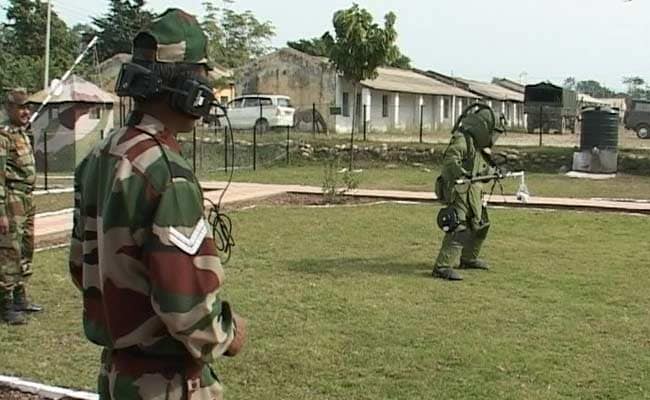
A bomb disposal squad member, wearing an armoured suit, tries to defuse an IED
Helping the bomb techs do their job are officers who communicate through radios. Video imagery of just what the bomb tech is seeing goes back to the officer from the helmet mounted camera.
Every minute is precious. Bomb technicians cannot work endlessly. Despite a cooling mechanism inside the bomb suit, working for more than half an hour at a time, particularly in our summer conditions, is almost impossible.
Ultimately, detecting and countering Improvised Explosive Devices is a non-stop life and death game heavily based on changing technology. The men in these bomb disposal units of the Indian Army know that they are only as good as their last successful operation in detecting an IED.
Track Latest News Live on NDTV.com and get news updates from India and around the world

